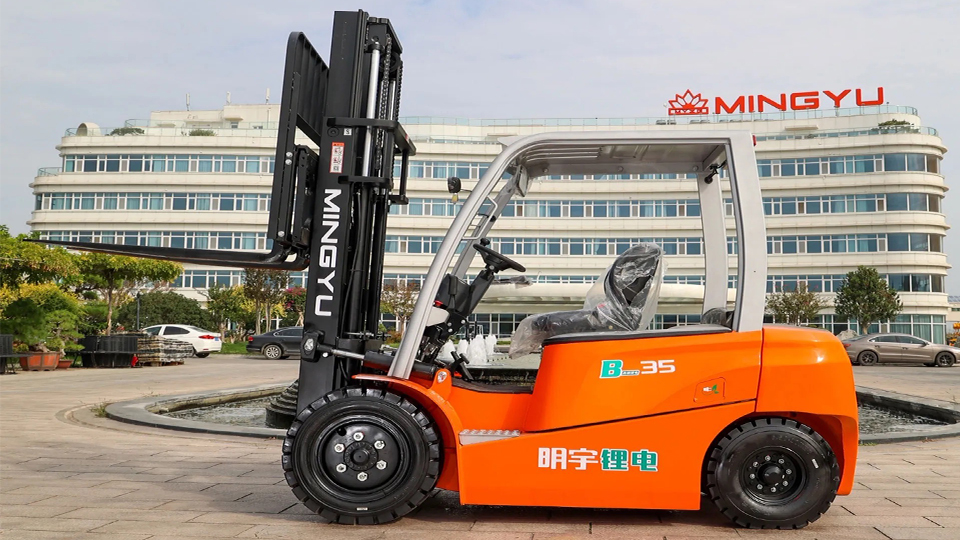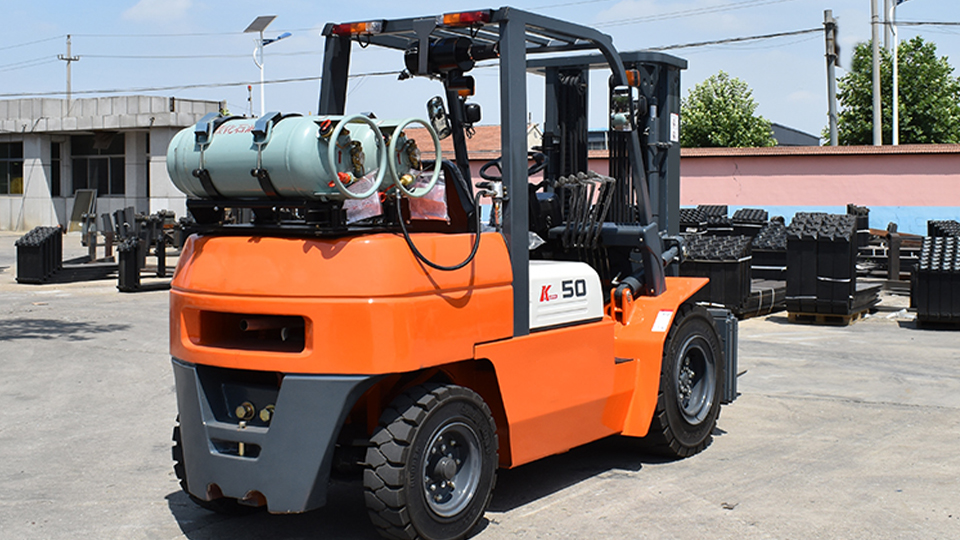
1. Fundamental Design Differences: Cushion vs. Pneumatic Chassis Forklifts are categorized and designed from the ground up to operate with a specific type of tire. The difference between a cushion tire (Class I, IV, V) and a pneumatic tire (Class V) model extends far beyond the wheels; it involves the entire chassis geometry, counterweighting, and axle configuration.1.1. Cushion Tire Forklifts (Press-On Tires)Cushion tire forklifts utilize solid rubber tires pressed directly onto a steel band or wheel hub.
2. They are purpose-built for:Environment: Smooth, flat surfaces, primarily indoor warehouses, paved yards, or finished concrete floors.Chassis: Compact, low-profile, and low-sitting. They have minimal ground clearance (often 3 to 5 inches).Maneuverability: Excellent. They have a small turning radius due to the tire's small diameter and the truck’s tight frame, making them ideal for narrow aisles.Axle Configuration: The axle is typically smaller and narrower and designed to handle the concentrated weight transfer of the small-diameter, solid cushion tires.1.2. Pneumatic Tire Forklifts (Air or Solid Rubber)Pneumatic tire forklifts use large, robust tires (similar to truck tires) filled with air (air pneumatic) or solid rubber (solid pneumatic/resilient). They are designed for:Environment: Rough, outdoor, or mixed-surface applications (gravel, dirt, construction sites, lumber yards).Chassis: Larger, wider, and taller with significantly greater ground clearance (often 6 to 10 inches).Stability: The wider wheelbase and larger tire footprint are necessary to maintain lateral stability and absorb shocks on uneven surfaces.Axle and Wheel Hubs: Require larger axles and specialized wheel hubs (often multi-piece rims for air pneumatics) to accommodate the increased size and dynamic forces of the large-diameter, wider tires.FeatureCushion Tire ForkliftPneumatic Tire ForkliftObstacle for ConversionGround ClearanceLow (3-5 inches)High (6-10 inches)Cannot be easily increased.

Turning RadiusSmall/TightLarge/WideChanging tire size affects steering geometry.Wheel Size/HubSmall diameter, press-on hubLarge diameter, bolt-on multi-piece rimHubs/axles are fundamentally incompatible.Frame WidthNarrow (for aisle use)Wide (for stability)Wider tires may interfere with frame.Stability (Center of Gravity)Low, highly dependent on small footprintHigh, dependent on wide wheelbase & tire flexAltering tire dimension severely compromises stability.
3. Technical Impossibility of Direct ConversionThe core issue is that pneumatic tires are fundamentally larger in diameter and wider than cushion tires. Attempting to fit a pneumatic tire onto a cushion tire chassis involves a series of insurmountable mechanical challenges.2.1. Wheel Hub and Axle IncompatibilityCushion tires are press-on; they consist of a rubber tire molded onto a steel band that is pressed onto a specialized hub. Pneumatic tires are bolt-on and use large, often multi-piece, rims that bolt directly to a much larger wheel hub.No Physical Fit: A cushion tire hub is not designed to accept a pneumatic rim, and vice versa. There is a complete incompatibility in the bolt pattern, hub diameter, and wheel offset.Axle Load Rating: The cushion tire's axle assembly (including bearings and spindles) is rated for the specific load distribution characteristics of a cushion tire, which has minimal side-to-side flex. The dynamic loads imposed by a larger, flexing pneumatic tire on rough terrain would likely exceed the design limits of the cushion tire axle, leading to catastrophic failure.
4. 2.2. Critical Chassis and Ground Clearance IssuesEven if a custom rim could be fabricated:Steering Interference: A pneumatic tire's increased diameter and width would instantly interfere with the forklift's chassis and counterweight components, particularly during steering and full axle lock. The tire would strike the fender, frame, or hydraulic hoses, rendering steering unusable.Minimal Ground Clearance: The primary reason for conversion—to gain ground clearance—would not be met. While the larger tire diameter increases the distance from the axle center to the ground, the chassis itself remains low. The low belly of a cushion tire forklift (often battery cases or low-slung counterweights) would still drag on uneven terrain, nullifying the benefit of the new tires.2.3. Hydraulic and Brake System ConstraintsThe increased rotational mass, diameter, and footprint of pneumatic tires fundamentally alter the vehicle's dynamics:Braking System: The braking system (drums or discs) is sized to stop the rotational inertia of the much lighter and smaller cushion tires. The increased inertia of large pneumatic tires would significantly reduce braking effectiveness, increasing stopping distances and creating a severe safety hazard.Steering Hydraulics: The steering system is optimized for the small rolling resistance and tight geometry of cushion tires. Maneuvering large, wide pneumatic tires would place excessive and potentially damaging strain on the power steering pump, hoses, and gearbox.3. The Overriding Regulatory and Safety ProhibitionThe most compelling reason not to attempt this conversion is the mandatory regulatory prohibition on unapproved equipment modification. This prohibition is universal across safety bodies like the Occupational Safety and Health Administration (OSHA) in the US and equivalent bodies globally.3.1. OSHA Standard 29 CFR 1910.178(a)(4)The OSHA standard for Powered Industrial Trucks explicitly addresses modifications:1910.178(a)(4): "Modifications and additions which affect capacity and safe operation shall not be performed by the customer or user without manufacturer's prior written approval. Capacity, operation, and maintenance instruction plates, tags, or decals shall be changed accordingly1."The Conversion Fails This Standard:Safety and Operation are Affected: Changing tire type and size is a profound modification that fundamentally alters stability, ground clearance, load distribution, and braking—all of which are critical to safe operation.No Manufacturer Approval: Forklift manufacturers do not provide written approval for converting a cushion tire model to a pneumatic tire model because it involves redesigning core structural components (axles, chassis, counterweight) that would effectively create a new, uncertified machine.Data Plate Invalidation: The load capacity and stability charts (data plate) on the forklift are based on the original tire dimensions. Changing the tires invalidates the data plate, making the truck immediately non-compliant and illegal to operate.3.2. Stability and Center of Gravity (C/G) ImplicationsThe stability triangle of a forklift is meticulously calculated based on its unladen weight, counterweight mass, and the dimensions of its footprint (the tires).Lateral Stability: Cushion tire trucks rely on their low center of gravity and the firmness of the solid tires. Adding taller, flexing (air-filled) pneumatic tires raises the center of gravity and introduces a "cushion" effect, which allows for greater load sway and roll. This significantly increases the risk of a lateral tip-over, especially when cornering or lifting loads high.Longitudinal Stability: The overall load capacity is affected by the increased moment arm created by the larger tire diameter. The truck would need a larger counterweight to maintain the same forward stability, which the chassis may not be designed to carry.
5. 4. The Correct Course of Action: The Right Tool for the JobAttempting a cushion-to-pneumatic conversion is an exercise in futility that results in an unsafe, non-compliant, and likely unusable machine. The cost and technical expertise required to safely redesign and re-certify the forklift would exceed the cost of purchasing a purpose-built unit.The proper technical solution is always to match the equipment classification to the operating environment:4.1. Option 1: Traction Cushion TiresFor light outdoor use on well-packed asphalt or dry, clean concrete, a user may be able to switch from smooth cushion tires to traction-tread cushion tires (if approved by the manufacturer). This provides slightly better grip than smooth tires but does not alter the fundamental chassis geometry, ground clearance, or stability data. This is typically the only tire change permitted on a cushion tire truck.4.2. Option 2: The Multi-Environment SolutionIf the application requires frequent indoor use and significant outdoor use on rough terrain, the technically sound and compliant solution is to acquire one of the following:Purchase a Purpose-Built Pneumatic Forklift: For high-capacity, heavy-duty outdoor work, a Class V (IC-powered) or large electric pneumatic forklift is required.Utilize Separate Fleets: Maintain the cushion tire truck for indoor operations (where its maneuverability is necessary) and a dedicated pneumatic tire truck for all outdoor work.

3. Option 3: Solid Pneumatic (Resilient) TiresSome operators use solid pneumatic tires (a type of solid rubber tire with the size and tread pattern of an air pneumatic tire) to gain some puncture resistance and better traction. However, this is only applicable to forklifts already designated and designed as pneumatic tire trucks. Putting this tire type on a cushion tire chassis still encounters the same wheel hub, frame clearance, and stability issues and is prohibited.Conclusion: Safety Over ModificationIn the field of material handling, the ability to put pneumatic tires on a cushion tire forklift is technically impossible for mechanical reasons and legally prohibited by safety regulations.A forklift is a precisely engineered machine where tire dimensions are integral to its rated capacity and stability triangle. Any unapproved modification, especially one as drastic as changing the entire tire type, violates the manufacturer’s certification and OSHA safety standards (29 CFR 1910.178), rendering the equipment unsafe, illegal, and voiding all liability coverage.The technical answer is firm: the risk of a catastrophic tip-over, axle failure, or braking system degradation mandates that a cushion tire forklift must remain a cushion tire forklift. The only responsible course of action for rough terrain operation is the procurement of a purpose-built pneumatic tire forklift.
Name: selena
Mobile:+86-13176910558
Tel:+86-0535-2090977
Whatsapp:8613181602336
Email:vip@mingyuforklift.com
Add:Xiaqiu Town, Laizhou, Yantai City, Shandong Province, China